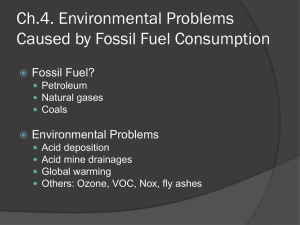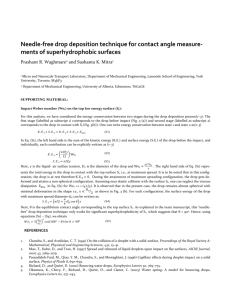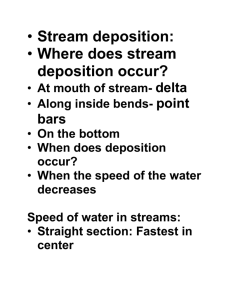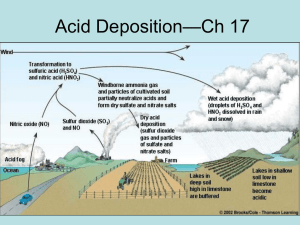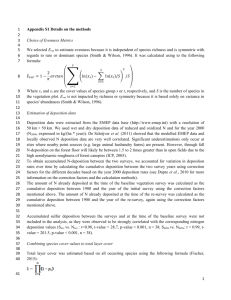MCRATECO4_AWMAPres
advertisement
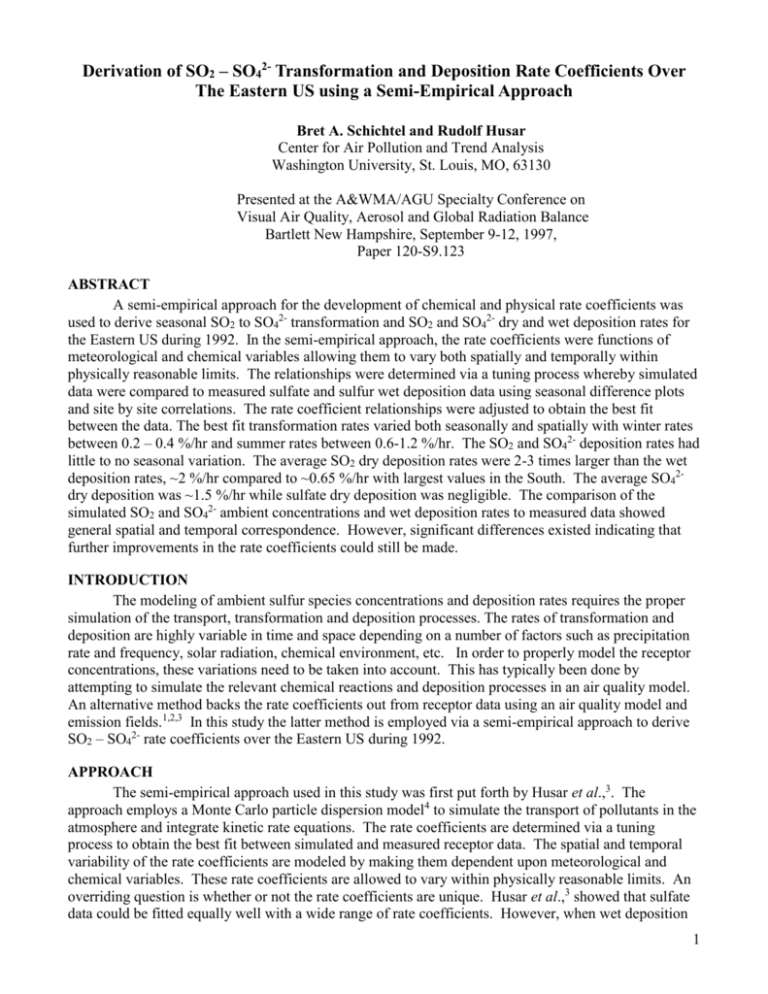
Derivation of SO2 – SO42- Transformation and Deposition Rate Coefficients Over The Eastern US using a Semi-Empirical Approach Bret A. Schichtel and Rudolf Husar Center for Air Pollution and Trend Analysis Washington University, St. Louis, MO, 63130 Presented at the A&WMA/AGU Specialty Conference on Visual Air Quality, Aerosol and Global Radiation Balance Bartlett New Hampshire, September 9-12, 1997, Paper 120-S9.123 ABSTRACT A semi-empirical approach for the development of chemical and physical rate coefficients was used to derive seasonal SO2 to SO42- transformation and SO2 and SO42- dry and wet deposition rates for the Eastern US during 1992. In the semi-empirical approach, the rate coefficients were functions of meteorological and chemical variables allowing them to vary both spatially and temporally within physically reasonable limits. The relationships were determined via a tuning process whereby simulated data were compared to measured sulfate and sulfur wet deposition data using seasonal difference plots and site by site correlations. The rate coefficient relationships were adjusted to obtain the best fit between the data. The best fit transformation rates varied both seasonally and spatially with winter rates between 0.2 – 0.4 %/hr and summer rates between 0.6-1.2 %/hr. The SO2 and SO42- deposition rates had little to no seasonal variation. The average SO2 dry deposition rates were 2-3 times larger than the wet deposition rates, ~2 %/hr compared to ~0.65 %/hr with largest values in the South. The average SO42dry deposition was ~1.5 %/hr while sulfate dry deposition was negligible. The comparison of the simulated SO2 and SO42- ambient concentrations and wet deposition rates to measured data showed general spatial and temporal correspondence. However, significant differences existed indicating that further improvements in the rate coefficients could still be made. INTRODUCTION The modeling of ambient sulfur species concentrations and deposition rates requires the proper simulation of the transport, transformation and deposition processes. The rates of transformation and deposition are highly variable in time and space depending on a number of factors such as precipitation rate and frequency, solar radiation, chemical environment, etc. In order to properly model the receptor concentrations, these variations need to be taken into account. This has typically been done by attempting to simulate the relevant chemical reactions and deposition processes in an air quality model. An alternative method backs the rate coefficients out from receptor data using an air quality model and emission fields.1,2,3 In this study the latter method is employed via a semi-empirical approach to derive SO2 – SO42- rate coefficients over the Eastern US during 1992. APPROACH The semi-empirical approach used in this study was first put forth by Husar et al.,3. The approach employs a Monte Carlo particle dispersion model4 to simulate the transport of pollutants in the atmosphere and integrate kinetic rate equations. The rate coefficients are determined via a tuning process to obtain the best fit between simulated and measured receptor data. The spatial and temporal variability of the rate coefficients are modeled by making them dependent upon meteorological and chemical variables. These rate coefficients are allowed to vary within physically reasonable limits. An overriding question is whether or not the rate coefficients are unique. Husar et al.,3 showed that sulfate data could be fitted equally well with a wide range of rate coefficients. However, when wet deposition 1 data was added to the fitting constraints the possible range of coefficients was reduced dramatically. It is hypothesized that given sufficient quality and quantity of data, it is possible to identify a unique set of rate parameters, thereby properly simulating the physical/chemical processes. The approach is semi-empirical in that it uses deterministic rate equations for the calculation of kinetic processes in a mass conserving model. It is empirical since the rate coefficients are dependent upon meteorological and chemical variables and the relationships are determined through a fitting process matching simulated to observed concentration and deposition fields. The tuning process involves a loop consisting of four procedures. The first procedure is the collection of input data sets. These data sets provide the necessary meteorological, emission, and measured concentration data for the generation and verification of modeled pollutant species. The next step is to formulate the model, creating the rate equations dependent upon the input data that can, in principle, reproduce the measured data. The third step is to determine the free constants in the rate equations that best reproduce the observed data. The last step involves the analysis of the results, and their comparison to the observed data. In this process, patterns of deviations are sought that can help explain the residuals. This, in turn, provides insights into revising the formulation of the rate equations, and potential problems or deficiencies with any of the first three steps. With the new insights, any of the previous three procedures can be re-addressed and revised. The process is completed when no new information can be discovered from the residuals. This approach for the generation of rate coefficient equations has several advantages. First, at any stage of development there is a functional tool that can provide best guess estimates. Deviations between the current simulation and the measured data provide clues and possible new insights as to how the physico-chemical frame can be improved, thereby, potentially generating new knowledge. The model is forced to fit a set of observed data, therefore it provides sophisticated interpolation and extrapolation of the tuning concentration data in space and time. Also, given adequate quantity and quality of data, the rate coefficient equations may evolve from a primarily empirical method to a mainly physico-chemical method capable of predications. The disadvantages of this approach are that the resulting rate coefficient equations may not generate unique rate constants or even be correct. Also, the rate coefficient equations are most suitable to the conditions for which they were developed. For example, if the chemical mix of the atmosphere changes markedly, then the kinetic rate constants derived previously may be inapplicable. INPUT DATA Meteorological Data The meteorological data was used as input in the Monte Carlo particle dispersion model to simulate the transport of pollutants and provide variables used in the rate coefficient equations. The meteorological data used in the study were: NGM Meteorological Data. The primary meteorological data set was obtained from the National Meteorological Center's Nested Grid Model (NGM).5 This database contains three dimensional wind fields, temperature and specific humidity as well as a number of surface variables, including mixing height. The data has a time step of 2 hours and is spatially configured on a polar stereographic grid covering most of North America with a grid size of approximately 160 km at 35 degrees latitudes. The upper air data are positioned on ten sigma surfaces relative to the model terrain, from approximately 150 m to 7000 m. The pollutant simulation was done using the NGM grid. Precipitation. Proper simulation of wet deposition is dependent on having valid precipitation fields. The NGM precipitation field was found to have spatially and temporally biased precipitation rates and frequencies. Therefore, they were replaced by measured data from the US Control COOP Hourly Precipitation database.6 The COOP database consists of approximately 2900 stations located throughout all 50 states in the US. The precipitation data was transformed to the NGM grid and time step by summing the measured precipitation rates over a two hour period, and spatially interpolating the 2 data to the NGM grid. The NGM precipitation data was used to fill in areas in Canada, Mexico, and off the coast of the US. Total Cloud Cover. The total cloud cover data were derived from the National Solar Radiation Database7. This database contains the synoptic surface reports from approximately 290 stations reporting synoptic weather over the United States every hour. The total cloud cover data was transformed to the same stereographic grid used by the NGM meteorological data using a similar technique to the re-mapping of the precipitation data. The grid points outside of the US were set to 60%, the average cloud cover over the US during 1992. Emissions SO2 emissions. The annual SO2 emissions came from the 1985 NAPAP emission inventory.8 The original data were provided as point and area emissions on a grid with resolution of 1 degree longitude and 2/3 degree latitude. The data were transformed to the meteorological grid by summing all point and area emissions together for all emission grid cells that fell into the same meteorological grid cell. No attempt was made to account for variations in 1992 emissions from those in 1985. However, it is estimated that the overall US SO2 emissions decreased about 5% since 1985.9 Concentration and Deposition Data Sulfate Concentrations. The sulfate concentration data were obtained from the IMPROVE (Interagency Monitoring of Protected Visual Environments) 10 and NESCAUM (Northeast States for Coordinated Air Use Management)11 monitoring networks. The IMPROVE network has 55 sites located in National Parks, wilderness areas, and rural areas, 13 of which are east of the Mississippi (Figure 1). The network collects aerosol samples over a twenty four hour period twice weekly. The NESCAUM network consists of 10 stations located in rural areas of the northeastern US. This network uses the same siting protocol and sampling method as IMPROVE, but collects samples three times a week.11,12 In the East, there are large areas that do not contain IMPROVE or NESCAUM monitoring sites, particularly in the Great Lake region and the South. To overcome the lack of stations, airport visibility data7,13 were used as a surrogate for spatially interpolating the fine sulfur aerosol between the monitoring sites, while maintaining the actual concentrations at the monitoring sites13 (Figure 2). Wet Deposition Data. The SO42- wet deposition data were obtained from the National Atmospheric Deposition Program/National Trends Network.14 This data contains the contributions from both SO2 and SO42- washout of the atmosphere. This network has 257 monitoring sites located throughout the US with every state having at least two monitoring sites (Figure 3). The network collects precipitation samples over a week’s time, and has been operating since 1978. THE PHYSICAL FORMULATION OF THE SO2 - SO42- RATE EQUATIONS The kinetic processes governing the atmospheric concentrations of SO2 and SO42- are the transformation of SO2 to SO42- and their removal by dry and wet deposition. The SO2 mass rate of change can be modeled by the rate equation: d ( SO2 ) ( kt k d 2 k w 2 )SO2 (1) dt Where kt, kd2, and kw2 are the oxidation, dry deposition, and wet deposition rate coefficients of SO2 respectively. Similarly, the rate of change of the SO42- mass is: d ( SO42 ) kt SO2 ( k d 4 k w4 )SO42 dt (2) Where kd4 and kw4 are the dry and wet deposition rate coefficients of SO42- respectively. Best Fit Rate Coefficients In the SO2 to SO42- rate equations, there are five rate coefficients that must be defined via the iterative tuning process. The tuning procedure began with the set of rate coefficient equations generated by Husar et al.,3. The development of the final set of rate coefficients involved many iterations, where 3 in each iteration simulated data was compared to fine particle sulfate and total SO42- deposition fields. The comparison involved analysis of seasonal difference and ratio plots where spatial biases were sought. Also, the daily sulfate and weekly sulfur deposition fields were compared using site by site correlation plots. In these plots the largest residuals were examined for commonalties. The rate coefficients were then modified to reduce the difference between simulated and measured data. Only one or two of the rate coefficients were changed for a given iteration to better understand the impact of these changes on all simulated fields. Schichtel 15 presents many of the intermediate steps leading to the final rate coefficient equations. The final set of rate coefficients is: kt = 0.001 + SR (0.02 + 0.05 SH/SHmax + 0.1*PF) (3) SR = (1-.65TS)GSR (4) kd2 = Vd / H (5) Vd = 0.22 + 2 * SR (6) kd4 = kd2/10 (7) kw2 = Ws2/ HS * P = Sqr(40000 / (SO2CC + 2)) * P (8) kw4 = Ws4/HS * P = 250 * P (9) where SR = ground level solar radiation [kW/m2] TS = total cloud cover GSR = ground level solar radiation in the absence of clouds [kW/m2] SH = specific humidity [kg Water/kg Air] SHmax = maximum specific humidity [kg Water/kg Air]: SHmax = 0.023 PF = precipitation flag, i.e. PF = 1 if it rains PF = 0 otherwise Vd = deposition velocity [cm/s] H = mixing height [m] Ws2, Ws4 = washout ratios for SO2 and SO42- respectively SO2CC = SO2 column concentration [mg/m2] P = precipitation rate [m/hr] HS = Scale Height [m]: HS = 1000 m SO2 to SO42- Transformation Rate The transformation rate, kt, (Equation 3) is composed of a background rate of 1 %/hr and a second term scaled by the ground level solar radiation (GSR). The GSR was used as the primary scaling factor because it mimics the diurnal and seasonal cycles of kt.16,17,18 Also, Wilson19 has demonstrated that much of the variation between measured oxidation rates over different parts of the day, season, and geographic location could be reduced by normalizing the data by the local solar radiation. The ground solar radiation is calculated from the extraterrestrial solar radiation at the top of the atmosphere using standard procedures 20 and is modulated based on cloud cover (Equation 4). The GSR scales the summation of a constant, a specific humidity term and a precipitation term. The specific humidity was added to enhance the oxidation rates during the summer and in the Southeast where initial simulations of sulfate were underestimating the measured data. The precipitation term accounts for the greater aqueous phase oxidation that occurs in clouds, and was added because initial simulations of sulfate were low after precipitation events. The minimum transformation rate is the background at 0.1 %/hr, and accounts for the oxidation during the night and the winter. The maximum rates during zero precipitation events were on the order of 4 %/hr and occurred during sunny summer days. During precipitation events the rates often exceeded 10 %/hr during the mid summer day. These rates are within the ranges of measured kt found for multiple plume studies in the Eastern US.19 For example, the measured kt from the Labadie power plant plume during July 1976 had maximum midday values less than 5 %/hr and night time and early morning values less than 0.5 %/hr . 19 4 SO2 and SO42- Dry Deposition Rates The dry deposition of SO2 is determined by atmospheric mixing, which delivers material to the surface, and by the absorptive properties of the surface. A convenient formulation for the dry deposition constant is kd = Vd/H, where H is the depth of the mixing layer, and Vd is the dry deposition velocity. The SO2 deposition velocity varies spatially, diurnally and seasonally.21,22 Results from a number of experimental studies compiled in Garland 21 and the National Research Council 22 list values of the SO2 deposition velocity between 0.1 - 2.2 cm/s. The maximum values occurred during the summer midday, and the minimum values occur during the night and winter. To account for these variations, the solar radiation was used as a scalar for Vd (Equation 4). A background Vd of 0.22 cm/s was assumed to occur at night and during the winter, and a maximum Vd of ~2 cm/s was assumed to occur during a sunny summer day. The dry deposition velocity for SO42- is limited by the aerosol fluid dynamical properties and is usually smaller than that for SO2. Measured deposition velocities of submicrometer diameter particles compiled by the National Research Council 22 range between 0.04 - 1 cm/s. Due to the small values of the sulfate Vd it was simply set to one tenth of the SO2's. Dry deposition only occurs if the material can interact with the surface. It was assumed that all mass above the mixing height was shielded from the surface, thus Vd was set to zero for all SO2 and SO42- mass above the mixing layer. SO2 and SO42- Wet Deposition Rates The SO2 and SO42- wet deposition was parameterized via the washout ratio W. The SO2 washout is strongly dependent on acidity and temperature with theoretical SO2 values between 104 and 105 for a pH range of 4 to 5 and a temperature of 15 oC.23 The variability due to pH was accounted for by defining the washout ratio as: WS2 = ( A / ([SO2CC]g + B) )1/2 where A and B are free constants found through the tuning procedure, and [SO2CC]g is the SO2 column concentrations (mg/m3). This relationship is based upon a simplified washout ratio equation derived from the SO2 solubility equations by Barrie. 23 The optimum values for the free constants were found to be A = 40000 mg/m2 and B = 2 mg/m2 (Equation 6). The washout ratio of sulfate aerosol is about an order of magnitude higher than SO2 on average21, with values between 3*105 and 8*105 in eastern Canada23, and average values of 106 in Europe.24 A constant SO42- washout ratio was used with the best fit value found to be 2.5*105. SEASONAL EFFECTIVE SO2 - SO42- TRANSFORMATION AND DEPOSITION RATES. The seasonal rate coefficients are presented in Figures 4 – 7. The averaging was conducted by weighting the rate coefficients by their respective SO2 or SO42- mass, providing effective rate coefficients of the bulk SO2 and SO42- at a given location and time. Figures 8 and 9 present the monthly effective rate coefficients for regions in Vermont and Alabama with the input meteorological parameters. The transformation rate coefficient displays a strong seasonal pattern increasing from 0.2 – 0.4 %/hr during the winter, Q1 and Q4, to 0.6 – 1.2 %/hr during the summer, Q2 and Q3 (Figure 4, 8A and 9A). The transformation rate also varies spatially increasing from north to south in all four quarters. This is largest during Q3 where kt increases by a factor of 2 from 0.6 %/hr in the north to 1.2 %/hr in Florida. The seasonality is driven by the solar radiation that peaks in June and the specific humidity that peaks later in the summer (Figure 12-14C). The spatial gradient is due to the increasing oxidation from the specific humidity and precipitation terms. During the summer, the specific humidity and precipitation terms account for 50% of the transformation rate in Vermont while in Alabama these terms account for 70% of the transformation rate. The SO2 removal rates show little seasonal variation (Figures 5 and 6). However, the wet deposition rates have high month to month fluctuation (Figures 8B and 9B) due to variable precipitation 5 (Figures 8D and 9D). The lowest wet deposition rates occur in the Central East with rate coefficients less than 0.6 %/hr for all quarters. The largest rates occur in the west from Minnesota to Texas where they can exceed 1.5%/hr. The Dry deposition rates vary between 1 – 3 %/hr for all four quarters (Figure 6). The lack of seasonality is due to both the mixing height and the dry deposition velocity, varying with the solar radiation so that their seasonal cycles cancel out (Figure 8E and 9E). The largest rates occur in the Industrial Midwest (IL, IN, OH) and the deep South (GA, AL, MS) where they are typically > 2 %/hr. Table 1 list the average rate coefficient over the entire Eastern US for each quarter. As shown, the dry deposition rate is the largest SO2 removal mechanism removing ~ 2 %/hr. This is 2-3 times larger than the average wet deposition rate coefficient. The SO2 removal due to oxidation is approximately equal to the wet removal at 0.75 %/hr during the summer, but is almost 2 times smaller than the wet removal during the winter. The sulfate seasonal wet deposition rates are presented in Figure 11. The sulfate wet deposition varies between 0.5 – 3 %/hr for quarter 2, 3, and 4, while quarter 1 has lower rates between 0.5 and 2 %/hr. The largest rates generally occur in the north. The wet deposition is the primary removal mechanism for sulfate with average values of 1.5 %/hr while sulfate dry deposition is negligible at ~ 0.15 %/hr (Table 1). COMPARISON OF SIMULATED SO42- CONCENTRATIONS AND WET DEPOSITION RATES TO OBSERVED DATA The resulting sulfate concentration and total SO42- wet deposition fields using the above rate equations 1992 are presented as seasonal isopleths in Figures 10 and 12. In Figure 11 and 13, the simulated and measured data are compared for the New England and Central East regions (Figure 1) using cross correlations. The simulated sulfate reproduces the general seasonal and spatial patterns of the observed data (Figures 2 and 10). The lower and more spatially uniform Q1 sulfate concentrations (2.5 – 5 g/m3) are reproduced, as well as the higher more variable Q3 concentrations (2.5 – 7 g/m3). However, the region of highest simulated sulfate concentrations is displaced from those seen in the observations. For example, the highest measured Q3 sulfate occurs over W. VA and northern VA at about 7 g/m3. The simulation shows this hot spot in southeast Ohio. The simulated sulfate also captures the daily sulfate fluctuations in New England and the Central East with r2 ~ 0.6 for the entire year (Figure 11). The simulated total SO42- wet deposition rates properly reproduced the seasonal variability of the observed data with the lowest deposition rates occurring during Q1 (0.5 – 2 g/m2/yr) and the highest rates occurring in Q3 ( 1 – 4.5 g/m2/yr) (Figure 3 and 11). The model deposition rates also closely match the spatial patterns of the observed data well reproducing the largest deposition rates, >4 g/m2/yr, south of Lake Erie and Ontario during Q3. However, the deposition rates along the East Coast, Florida, and the western part of the model domain are underestimated by a factor of 1.5 to 2. The simulated deposition rates capture the weekly variability in the New England and Central East regions with a r2 ~ 0.8 for the year (Figure 13). But the New England deposition rates are underestimated by about 25%, 1.71 g/m2/yr compared to 2.15 g/m2/yr. SUMMARY AND DISCUSSION A semi-empirical approach for the development of chemical and physical rate coefficients is used to derive seasonal SO2 to SO42- transformation and SO2 and SO42- dry and wet deposition rates for the Eastern US during 1992. The semi-empirical approach makes maximal use of available meteorological, emission, and receptor data in conjunction with a physico-chemical model. The rate coefficients are functions of meteorological and chemical variables where the relationships are determined via a tuning process which strives to obtain the best fit between simulated and measured data. The rate coefficients vary both spatially and temporally, but were considered to be within physically reasonable limits. It is hypothesized that given sufficient quality and quantity of data it will 6 be possible to identify a unique set of rate parameters, thereby properly simulating the physical/chemical processes. This approach was applied to the Eastern US using the 1985 NAPAP emission fields and a Monte Carlo Dispersion model used to simulate the transport and integrate kinetic rate equations. Characteristics of the resulting mass weighted seasonal SO2 to SO42- rate processes are given below: The transformation rate varied both seasonally and spatially with winter rates between 0.2 – 0.4 %/hr and summer rates between 0.6-1.2 %/hr. The higher rates being in the South. The SO2 and SO42- dry and wet deposition rates have little to no seasonal variation. The SO2 dry deposition rates peak in the South and Industrial Midwest where they can exceed 2.5 %/hr. The SO2 wet deposition rates peak in the west from Minnesota to Texas where they can exceed 1.5%/hr. The average dry deposition rates (~2 %/hr) are 2-3 timers larger than the wet deposition rates (~0.65 %/hr). The average sulfate dry deposition is ~1.5 %/hr while sulfate dry deposition is negligible, ~ 0.15 %/hr. The comparison of the simulated SO2 and SO42- ambient concentrations and wet deposition rates to measured data showed general spatial and temporal correspondence. However, regions of the highest simulated seasonal sulfate concentrations were spatially displaced from the measure data, and the sulfur wet deposition rates were underestimated along the East coast and west of the Mississippi by up to a factor of 2. These differences indicate that improvements in the rate coefficients can still be made. For example, a possible improvement is a better accounting of cloud processes, which can greatly enhance the oxidation of SO2 to SO42-. Also, all sources were assumed to release pollutants near the ground surface. Properly simulating the source elevations could have a significant effect on the SO2 dry deposition rates, particularly in the Industrial Midwest that has a number of elevated point sources. Other uncertainties in the rate coefficients arise from errors in the pollutant transport and emission fields. In the tuning procedure it was assumed that both the transport and emissions were non biased so any errors would “average out”. If these inputs contain biases, then the rate coefficients will compensate for them. There are no known biases in the transport calculation, but the emission fields may be biased high. The 1985 emission fields were used to simulate 1992 data, and it is estimated that the overall US SO2 emissions have decreased about 5%9. The rate coefficients presented are our current best estimates based upon the available data. The rate coefficients will change in the future as more receptor data becomes available, and important processes such as source stack height are better taken into account. However, it is believed that these changes will not qualitatively change the seasonal rate coefficients presented. REFERENCES 1. 2. 3. 4. 5. 6. 7. Eliassen A; The OECD Study of long-range transport of air pollutants: Long range transport modeling. Atmos. Environ. 1978 / 12, 479-487. Eliassen A. and Saltbones J; Modeling of long-range transport of sulphur over Europe: a two-year model run and some model experiments. Atmos. Environ, 1983. 17, 1457-1473. Husar, R.B., D.E. Patterson, W.E. Wilson; A semi-empirical approach for selecting rate parameters for A Monte Carlo regional model. CAPITA Publication 86r2 ,Washington University St. Louis MO, 63130, 1986. Schichtel B.A., Husar R.B; Regional Simulation of Atmospheric Pollutants with the CAPITA Monte Carlo Model.; Journal of the Air & Waste Management Association, 1996, 47, pp. 331-343. Rolph G.D; NGM Archive. NCDC Report TD-6140, July, National Climatic Data Center, 1992. NCAR (National Center for Atmospheric Research); DS505.0 NCDC TD3240, US Controlled Hourly precipitation, Daily 1948-Cont, 1995. National Renewable Energy Laboratory (NREL); User’s Manual: National Solar Radiation Database (1961-1990), 1.0., National Climatic Data Center, Federal Building, Asheville, NC 28801. Sept. 1992 7 8. 9. 10. 11. 12. 13. 14. 15. 16. 17. 18. 19. 20. 21. 22. 23. 24. Irving, Patricia M; Acidic Deposition: State of Science and Technology, Vol. I, Report 1, (Emissions). Available from Superintendent of Documents, Government Printing Office, Washington, DC 20402-9325, 1991. US Environmental Protection Agency;. AIRS User’s Guide, Volume AQ1: AQS Data Dictionary. EPA-454/B-94-005, February 1994. Sisler J.F., D. Huffman, D.A. Latimer, W.C. Malm, and M. Pitchford; Spatial and temporal patterns and the chemical composition of the haze in the Unites States: An analysis of data from the IMPROVE network, 1988-1991. Report #ISSN No. 0737-5352-26 CIRA, CSU, Fort Collins, CO., 1993. Poirot, R. L., P. J. Galvin, N. Gordon, S. Quan, A.V. Arsdale, and R.G. Flocchini;. Annual and seasonal fine particle composition in the Northeast: second year results from the NESCAUM monitoring network. Presented at the A&WMA conference in Vancouver, Canada. Paper No. 91-49.1, 1991. Schichtel B.A et al; Aerosol Composition, Washington University, St. Louis MO, 63130, 1992 Husar, R.B. and Husar, J.D;. Fine particle maps derived from regional PM2.5 and visibility data. Final Report to Radian Corporation, 3200 Progress Center/Nelson Hwy, P.O. Box 13000 Research Triangle Park, NC 27709. EPA Contract Number 68-D2-0160, Work Assignment Number 2 032,. 1995 (NADP/NTN) National Atmospheric Deposition Program (NRSP-3)/National Trends Network; NADP/NTN Coordination Office, Natural Resource Ecology Laboratory, Colorado State University, Fort Collins, CO 80523, 1993. Schichtel, B.A; Retrieval of Emission Field; Doctoral Dissertation, Washington University, St. Louis, MO 1996. Husar, R.B., D.E. Patterson, W.E. Wilson; A Semi-Empirical Approach For Selecting Rate Parameters For A Monte Carlo Regional Model. CAPITA Publishing 86r2, Washington University St. Louis MO, 63130. 1986 Gillani, N.V; Gas to Particle Conversion of Sulfur in Power Plants Plumes. Atmos. Environ. 1981 15, 2293-2313 Calvert, J.G., and Mohnen, V; Chemistry of acid formation. In: Acid Deposition: Atmospheric Processes in Eastern North America , National Academy of Sciences, Washington, DC., 1983 ; pp.155-201, Wilson, W.E;.. Sulfate formation in point source plumes: a review of recent field studies. . Atmos. Environ. 1981 15, 2573 - 2581. Kondrateyev, K.Ya.; Radiation in the Atmosphere. Academic Press, NY. 1969 Garland, J.A; . Dry and wet removal of sulphur from the atmosphere. Atmos. Environ,. 1981, 12, 349 - 362. National Research Council; Acid Deposition: Atmospheric Processes in Eastern North America, National Academy of Sciences, Washington, D.C., 1983, pp. 155-201 Barrie, L.A; The prediction of rain acidity and SO2 scavenging in Eastern North America. Atmos. Env., 1981, 15, 31-41. Whelpdale, D.M; Sulfate scavenging ratios at Norwegian EMEP stations. EMEP/CCC Report 5/81, Norwegian Institute for Air Research. 1981. Table 1. Average seasonal rate coefficient over the Eastern US Q1 Q2 Q3 Q4 kt kw2 kd2 kw4 kd4 0.33 0.74 0.79 0.31 0.54 0.671 0.81 0.61 2 1.7 1.9 1.9 1.3 1.6 1.7 1.2 0.16 0.13 0.14 0.15 Figure 1. The spatial domains used to average the simulated and observed SO42- concentrations and wet deposition rates. The symbol represents the IMPROVE and NESCAUM aerosol monitoring sites, the NADP wet deposition sites, and the center of simulated receptor grid cells. 8 Figure 2. Seasonal “observed” sulfate concentration fields generated from the fusion of IMPROVE and NESCAUM fine sulfur measurements and airport visibility data. Figure 3. Seasonal 1992 SO42- wet deposition rates from the NADP monitoring network data. 9 Figure 4. The seasonal effective SO2 to SO42- transformation rates for 1992. The averaging was conducted by weighting rate coefficients by SO2 mass. Figure 5. The seasonal effective SO2 wet deposition rates for 1992. The averaging was conducted by weighting the rate coefficients by the SO2 mass. 10 Figure 6. The seasonal effective SO2 dry deposition rates for 1992. The averaging was conducted by weighting the rate coefficients by the SO2 mass. Figure 7. The seasonal effective SO42- wet deposition rates for 1992. The averaging was conducted by weighting the rate coefficients by the SO42- mass. 11 Figure 8. The effective rate coefficients averaged over each month in Vermont and the input meteorological parameters. The averaging was performed by weighting each rate coefficient by the SO 2 or SO42- mass. Figure 9. The effective rate coefficients averaged over each month in Alabama and the input meteorological parameters. The averaging was performed by weighting each rate coefficient by the SO2 or SO42- mass. 12 Figure 10. Simulated seasonal SO42- concentration fields during 1992. New England Daily SO42- Concentrations, g/m3 6 12 6 9 12 15 18 Observed 0 Q3 Simulation 9 6 0 0 18 3 6 9 12 15 18 Observed 3 6 3 6 9 12 15 18 Observed 9 6 6 9 12 Observed 15 6 9 12 Observed 15 18 0 3 6 9 12 15 18 Observed Q4 12 9 6 3 0 0 18 3 y = 0.76x + 1.02 R2 = 0.40 15 0 3 0 18 3 0 6 3 0 Q3 12 9 0 0 6 9 12 15 18 Observed y = 0.84x - 0.36 R2 = 0.61 15 3 0 3 18 12 9 0 0 y = 1.18x - 0.48 R2 = 0.72 15 12 6 9 12 15 Observed 6 12 3 Q3 18 18 y = 0.93x + 0.63 R2 = 0.56 15 3 Simulation 3 6 9 3 0 0 0 6 9 y = 0.73x + 0.54 R2 = 0.59 15 12 12 3 3 0 9 YEAR 18 y = 0.80x - 0.17 R2 = 0.56 15 Simulation 9 Q2 18 y = 0.69x + 0.51 R2 = 0.35 15 Simulation 6 12 Q1 18 Simulation 9 Simulation Simulation Simulation 12 YEAR 18 y = 1.03x - 0.18 R2 = 0.64 15 y = 0.88x - 0.13 R2 = 0.83 15 3 Simulation Q2 18 y = 1.61x - 1.69 R2 = 0.80 15 Simulation Q1 18 Central East Daily SO42- Concentrations, g/m3 3 6 9 12 Observed 15 18 0 3 6 9 12 15 18 Observed Figure 11. Comparison of the daily averaged simulated SO 42- concentrations, during 1992, to the NESCAUM/IMPROVE measurements over a New England and Central East domain, as defined in Figure 1. Figure 12. Simulated seasonal SO42- wet deposition fields during 1992. New England Weekly Total SO42- Wet Deposition Rates, g/m2/yr 6 7 Q3 7 6 5 4 3 2 1 0 0 2 3 4 5 Observation 6 7 Q4 7 6 5 4 3 2 1 0 Simulation 0 1 2 3 4 5 Observation 6 7 0 1 2 3 4 5 Observation 6 0 7 1 2 3 4 5 Observation 6 7 Q3 7 6 5 4 3 2 1 0 y = 0.82x + 0.17 R2 = 0.82 Simulation y = 0.68x + 0.28 R2 = 0.68 1 0 1 2 3 4 5 Observation 6 7 y = 0.81x + 0.20 R2 = 0.83 Simulation 0 1 2 3 4 5 Observation 6 7 6 7 0 1 2 3 4 5 Observation 6 7 Q4 7 6 5 4 3 2 1 0 y = 0.67x + 0.65 R2 = 0.71 YEAR 7 6 5 4 3 2 1 0 y = 0.92x - 0.17 R2 = 0.84 y = 0.88x + 0.10 R2 = 0.89 Simulation 2 3 4 5 Observation Q2 7 6 5 4 3 2 1 0 y = 0.93x + 0.01 R2 = 0.86 Simulation 1 Q1 7 6 5 4 3 2 1 0 y = 0.72x + 0.16 R2 = 0.79 Simulation Simulation Simulation 0 YEAR 7 6 5 4 3 2 1 0 y = 0.80x - 0.07 R2 = 0.94 Simulation Q2 7 6 5 4 3 2 1 0 y = 0.61x + 0.21 R2 = 0.50 Simulation Q1 7 6 5 4 3 2 1 0 Central East Weekly Total SO42- Wet Deposition Rates, g/m2/yr 0 1 2 3 4 5 Observation 6 7 0 1 2 3 4 5 Observation Figure 13. Comparison of the simulated weekly total SO42- wet deposition rates, during 1992, to NADP observations over a New England and Central East domain, as defined in Figure 1. 13

